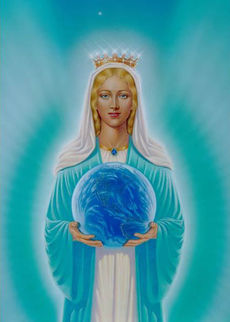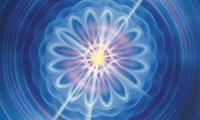Hail Mary/fi: Difference between revisions
EijaPaatero (talk | contribs) (Created page with "Joka kerta lausuessamme Terve Maria -rukouksen tervehdimme Äitisädettä omassa olemuksessamme, peruschakraan keskittynyttä energiaa eli Jumalan puhdasta valkoista valoa.") |
EijaPaatero (talk | contribs) (Created page with "Kun sanomme: "Terve, Äitisäde", aktivoimme tuon voimakentän, ja vähitellen, hiukan kerrallaan se nousee hitaasti, luonnollisesti ja Jumalan lakien mukaisesti, pakottamatta...") |
||
| Line 8: | Line 8: | ||
Joka kerta lausuessamme Terve Maria -rukouksen tervehdimme Äitisädettä omassa olemuksessamme, peruschakraan keskittynyttä energiaa eli Jumalan puhdasta valkoista valoa. | Joka kerta lausuessamme Terve Maria -rukouksen tervehdimme Äitisädettä omassa olemuksessamme, peruschakraan keskittynyttä energiaa eli Jumalan puhdasta valkoista valoa. | ||
Kun sanomme: "Terve, Äitisäde", aktivoimme tuon voimakentän, ja vähitellen, hiukan kerrallaan se nousee hitaasti, luonnollisesti ja Jumalan lakien mukaisesti, pakottamatta ja vaarantamatta sielun kehitystä. | |||
== Origins of the prayer == | == Origins of the prayer == | ||
Revision as of 14:10, 30 May 2023


the Spoken Word
Tervehdys, joka tarkoittaa "Terve, Äitisäde" (Maria, Mary, Ma-ray); ylistys kaikissa elämän osissa olevalle Äitiliekille.
Joka kerta lausuessamme Terve Maria -rukouksen tervehdimme Äitisädettä omassa olemuksessamme, peruschakraan keskittynyttä energiaa eli Jumalan puhdasta valkoista valoa.
Kun sanomme: "Terve, Äitisäde", aktivoimme tuon voimakentän, ja vähitellen, hiukan kerrallaan se nousee hitaasti, luonnollisesti ja Jumalan lakien mukaisesti, pakottamatta ja vaarantamatta sielun kehitystä.
Origins of the prayer
The first part of the Hail Mary is the angelic salutation of Gabriel, “Hail, Mary, full of grace, the Lord is with thee.” (Luke 1:28) To this was added Elisabeth’s salutation to Mary, “Blessed art thou among women, and blessed is the fruit of thy womb.” (Luke 1:42)
The third part of the Hail Mary was inspired by the Council at Ephesus in A.D. 470. The prayer “Holy Mary, Mother of God, pray for us sinners, now and at the hour of our death” settled the Nestorian heresy which arose from the mouth of Anastasius, “Let no one call Mary the mother of God, for Mary was a human being; and that God should be born of a human being is impossible.”[1] With this additional affirmation, the Council at Ephesus affirmed the Motherhood of God for all of Christendom.
The meaning of “Mother of God”
Mother Mary explained her calling as the Mother of God:
I AM a cosmic mother, and as much your mother as I am the mother of beloved Jesus. Some who are adherents of the Christian faith call me the Mother of God. To those of the protesting branch of orthodox Christianity this seems a sacrilege; for men may well ask, “Who is worthy to be the Mother of God?”
But this concept, when understood to mean the mother of the embodiment of the Divine Spirit, reveals the glorious truth that every mother who understands that which was spoken—“and the Word was made flesh and dwelt among us”[2]—may be the Mother of God.[3]
To mother means to give birth to, to give rise to, to care for, and to protect. Therefore, to be the mother of God is to give birth to, to give rise to, to care for, and to protect His Flame on earth. To mother the Flame of Spirit in the plane of Matter is the calling of the Feminine Ray in both man and woman.
Affirming our victory rather than our death
The third part of the Hail Mary succeeded in affirming the Motherhood of God; however, it also assigned to man the role of sinner and emphasized death as the end of the life of the sinner. Mother Mary has said that Keepers of the Flame ought not to affirm their sinful nature, but rather their rightful inheritance as sons and daughters of God; nor should they dwell upon the hour of death, but rather upon the hour of victory.
The Mother of Jesus therefore asked that we pray for her intercession “now and at the hour of our victory over sin, disease, and death,” thereby drawing their attention to the hour of victory over all conditions of time and space which her blessed Son proved in his life and in the hour of his victorious ascension. She affirmed the “hour of our victory” to be the eleventh hour when the greatest vigilance is required to countermand the backlash of the tail of the dragon depicted by Saint John the Revelator as being wroth with the Woman and going forth to make war with the remnant of Her Seed.
She promised to assist Keepers of the Flame, disciples of Christ, and devotees of the Mother Flame in winning their victory and the victory for all mankind if they would thus pray to her:
- Terve Maria armoitettu
- Herra sinun kanssasi
- Siunattu sinä vaimojen joukossa
- ja siunattu kohtusi hedelmä Jeesus
- Pyhä Maria Jumalan äiti
- rukoile Jumalan poikien ja tyttärien puolesta
- nyt ja hetkellä kun voitamme
- synnin, sairauden ja kuoleman
Purpose of the Hail Mary
When we say, “Hail Mary!” we are greeting the Woman clothed with the Sun, the feminine principle of the Godhead, whom we know and love surely and above all in the beautiful Mother of Christ but who is also resident, though dormant, in man, in woman and as the light in our innermost being. The white sphere of the Mother is sealed in the sacral, or sacred, base chakra until we love her enough to magnetize her—to actually coax her to mount the spiral staircase and rendezvous with our souls in our very heart of hearts. Here in the Holy of holies, we recite the Hail Mary with her, we enthrone her as our beloved Mother, and she reunites us with the Trinity, the threefold flame of life. She takes us by the hand and leads us all the way to the summit of Being, the crown of crowns where God is All-in-all.
Mother Mary has assured us that the path of Kundalini yoga is indeed a part of Western tradition. And this is why she appeared to several of the saints with the safe and sound method of raising the Mother light through the rosary. This is why the saints have been portrayed with a white light upon their heads—because they have opened their crown chakras and entered into direct oneness with the I AM Presence. They have entered into the bliss of God.
See also
For more information
Elizabeth Clare Prophet, Mary’s Message for a New Day.
Sources
Elizabeth Clare Prophet, Inner Perspectives, chapters 50 and 55.
Elizabeth Clare Prophet, Mary’s Message for a New Day, preface.
Elizabeth Clare Prophet, Mary’s Message for a New Day, part 2, “Christian Prayer Forms and the Evolution of the Rosary.”
